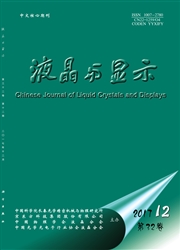

 中文摘要:
中文摘要:
采用紫外光聚合诱导相分离方法制备了聚合物分散胆甾相液晶膜,系统研究了固化光强和固化温度等制备条件对薄膜的相形态的影响,并探讨了薄膜相形态与反射率的关系。研究表明:固化光强较低时相分离较完全,产生的液晶微滴尺寸较大,聚合物与液晶的界面非常光滑;增加光强会使液晶微滴尺寸变小,界面变粗糙,膜反射率逐步降低。相形态与固化温度的关系较为复杂:在温度较低时,液晶以圆形液滴的形式分散在聚合物基体中;随着固化温度升高,液晶液滴逐渐变大,并在40℃时形成了连续的液晶层和聚合物层的分层结构;进一步升高温度,则形成了三维的聚合物网络结构,液晶相贯穿其间。膜的反射率先随着固化温度的升高逐渐升高,而后又降低。固化光强为0.01mW/cm2,固化温度为40℃时,反射率达到最大值32.2%。
 英文摘要:
英文摘要:
Polymer dispersed cholesteric liquid crystal(PDCLC) films are prepared by means of ultraviolet(UV) induced phase separation.The effects of UV cure power and UV cure temperature on morphology of PDCLC have been studied in detail,the relationship between morphology of PDCLC and reflectivity has also been studied.The results show that low UV cure power allows complete phase separation,large LC domains size and smooth interface between polymer and LC.Strong UV cure power results in a rough interface which also decreases the size of LC domains and reflectivity of PDCLC films.But the relationship of PDCLC morphology and UV cure temperature is complex.At low UV cure temperature,LC dispersed as circular droplets in polymer matrix.The size of LC domains become bigger which yield adjacent and uniform layers of LC and polymer when the UV cure temperature is up to 40 ℃.Higher UV cure temperature causes a type of three-dimensional polymer network structure in which LC is dispersed.Reflectivity of PDCLC films is up first and down later with UV cure temperature increasing.In this paper,the PDCLC films prepared with UV cure power 0.01 mW/cm2 and UV cure temperature 40 ℃ exhibit max reflectivity of 32.2%.
 同期刊论文项目
同期刊论文项目
 同项目期刊论文
同项目期刊论文
 期刊信息
期刊信息
